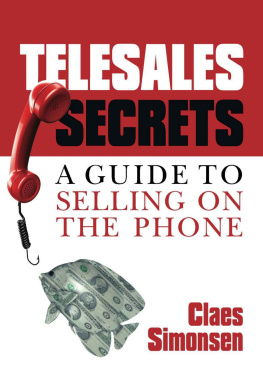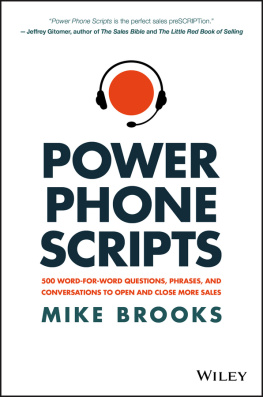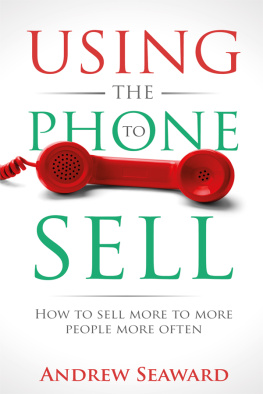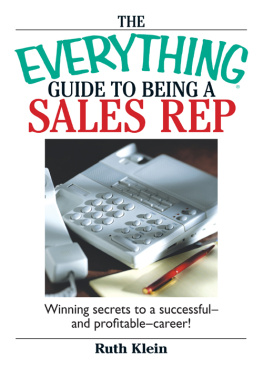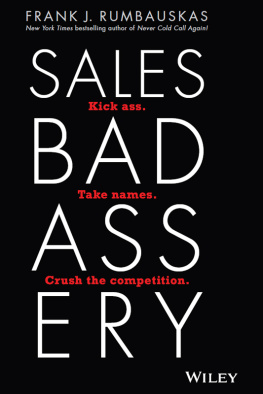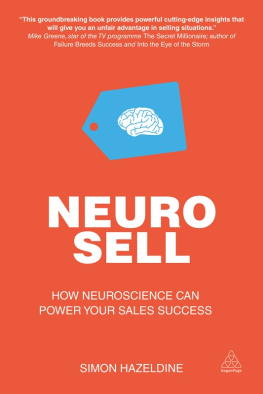
Table of Contents
Guide
Pages
ALEX GOLDFAYN
Wall Street Journal Bestselling Author of 5-Minute Selling
PICK UP THE PHONE AND SELL
HOW PROACTIVE CALLS TO CUSTOMERS AND PROSPECTS CAN DOUBLE YOUR SALES

Copyright 2022 by Alex Goldfayn. All rights reserved.
Published by John Wiley & Sons, Inc., Hoboken, New Jersey.
Published simultaneously in Canada.
No part of this publication may be reproduced, stored in a retrieval system, or transmitted in any form or by any means, electronic, mechanical, photocopying, recording, scanning, or otherwise, except as permitted under Section 107 or 108 of the 1976 United States Copyright Act, without either the prior written permission of the Publisher, or authorization through payment of the appropriate per-copy fee to the Copyright Clearance Center, Inc., 222 Rosewood Drive, Danvers, MA 01923, (978) 750-8400, fax (978) 646-8600, or on the Web at www.copyright.com. Requests to the Publisher for permission should be addressed to the Permissions Department, John Wiley & Sons, Inc., 111 River Street, Hoboken, NJ 07030, (201) 748-6011, fax (201) 748-6008, or online at http://www.wiley.com/go/permissions.
Limit of Liability/Disclaimer of Warranty: While the publisher and author have used their best efforts in preparing this book, they make no representations or warranties with respect to the accuracy or completeness of the contents of this book and specifically disclaim any implied warranties of merchantability or fitness for a particular purpose. No warranty may be created or extended by sales representatives or written sales materials. The advice and strategies contained herein may not be suitable for your situation. You should consult with a professional where appropriate. Neither the publisher nor author shall be liable for any loss of profit or any other commercial damages, including but not limited to special, incidental, consequential, or other damages.
For general information on our other products and services or for technical support, please contact our Customer Care Department within the United States at (800) 762-2974, outside the United States at (317) 572-3993 or fax (317) 572-4002.
Wiley publishes in a variety of print and electronic formats and by print-on-demand. Some material included with standard print versions of this book may not be included in e-books or in print-on-demand. If this book refers to media such as a CD or DVD that is not included in the version you purchased, you may download this material at http://booksupport.wiley.com. For more information about Wiley products, visit www.wiley.com.
Library of Congress Cataloging-in-Publication Data is Available:
ISBN 9781119814603 (Hardcover)
ISBN 9781119814641 (ePDF)
ISBN 9781119814658 (ePub)
Cover design: PAUL MCCARTHY
To my mom, Jane Goldfayn, who makes proactive calls to me every single day.
She was the first writer in the family.
PART ONE
INTRODUCTION
CHAPTER 1
THE LOST ART OF PROACTIVE CALLING IN THE SALES PROFESSION
This is the most obvious book I've ever written.
You're reading my fifth book on sales growth, but none has been as clearly necessary and important to write as this one. Especially now, in a post-pandemic world, where we cannot see our customers nearly as much as we previously could.
In the selling profession, only the phone is so universally understood to be the key to success and, at the same time, so widely avoided. A surprisingly large number of salespeople even dread it.
In the 1980s and so many of the decades that came before, if you wanted to sit in your office and communicate with a lot of people quickly, the only option you had was the wired landline telephone.
So a lot of salespeople had no choice but to be really good at using the phone.
In the late 1990s, we got email. It was faster. And easier.
And, over time, many of us moved to email as our preferred method of communicating with customers and prospects.
Then we got cell phones.
And text messages.
And then social media rolled in:
We could have Facebook pages.
And LinkedIn connections.
And we could tweet at people.
All of these things were also faster, easier, and far less threatening than the phone.
So we went to them.
Because on these platforms, rejection is usually simply silence, whereas on the phone, it's intimate and personal and spoken directly into our ears.
Of course, we still have meetings, and we're good at them because we never really stopped having them.
But how many meetings can you have in a day? About as many as an hour's worth of phone conversations.
And so, over the last few Internet decades, the entire sales profession has moved away from what so many used to excel at: proactive phone calls to customers and prospects.
What's a proactive call?
Communicating by phone with customers and prospects when nothing is wrong.
I run a large solo consulting practice, working with business-to-business organizations to grow their sales. My clients average 1020% in additional new sales growth annually directly from our work together. Even large companies, in mature industries. Even companies that have been stagnant and have not added significantly to their sales in years. Even these companies add 1020% in new sales.
Individually, many salespeople double and sometimes even triple their sales when applying the techniques I teach them techniques I lay out in this book.
How would doubling your sales numbers improve your life?
Or maybe only increasing them by 50% what would that do for you and your family?
How do my client salespeople achieve this kind of growth?
Centrally, with the phone.
By letting customers and prospects hear from them proactively.
By being present.
By being interested.
By demonstrating that they care.
How?
Almost entirely with the phone.
Before the pandemic, I did 75 to 100 speeches and workshops each year focused on my techniques for sales growth.
When the pandemic besieged us, I continued doing live sessions virtually, but because salespeople couldn't see their customers any more, I doubled down on how to use the phone to grow sales.
Many of these sessions were in multiple parts often a series of three sessions, with the same audience each time.
By the third webinar, after spending at least two hours exploring the ins and outs of telephone selling, I would ask the attendees what they'd like me to focus on. I like to go where my audiences want me to go.
I would even give options:
- Do you want to talk about selling more to existing customers?
- Or asking for referrals?
- Or following up on quotes or proposals?
- What about asking for the business?
- Or do you want me to go over phone selling some more? (Keep in mind, this was the dominant topic of the previous two sessions these same people had attended.)
Via the chat function, people made their requests. The vast majority of topics salespeople wanted to cover centered on selling over the phone:
- When should we call?
- Who should we call?
- What if we don't have the customer's cell phone number?
- Do I leave a voice message?
Next page

